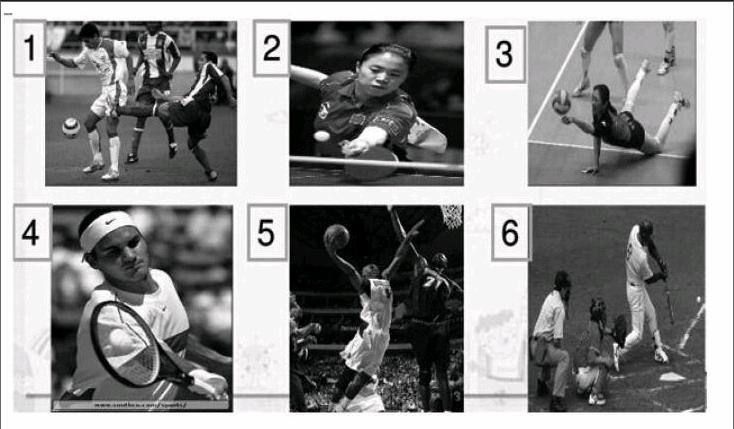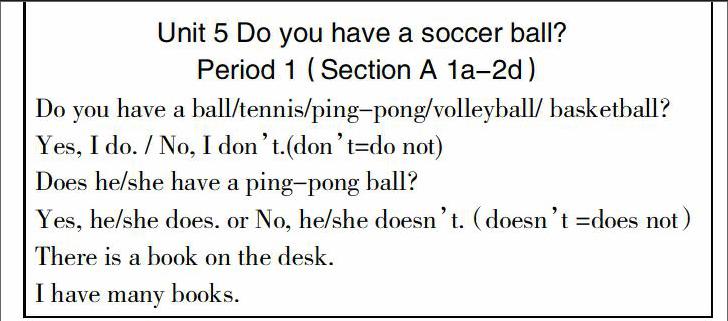“Unit 5 Do you have a soccer ball? Period 1 (Section A 1a—2d)”教學設計及設計說明(一)
唐德志


編者按:一般現在時態是初中英語教學中學生接觸的第一個時態,掌握好這個時態的用法是學好英語的基礎。七年級上冊的Unit 5是以“談論物品所屬關系”為主題, 以同學之間談論各自擁有的物品進行的語言學習活動,目的是使學生能夠靈活運用一般現在時態的一般疑問句形式,詢問物品所屬關系,并做出回答。利用話題談論讓學生掌握生澀、枯燥的語法,體現了人教版教材的編寫宗旨,和英語作為語言學科的交際和交流的工具性。為達到以上教學目標,我們將呈現兩位教師對同一課時的不同設計,以期從不同的視角探討教學的多種形式。
〔此課選自人教版義務教育課程標準實驗教科書《英語》(新目標2013版)七年級上冊。〕
一、教學內容與分析
本單元的話題是運用have的一般現在時及其一般疑問句來談論物品所屬關系。這個話題貼近學生的日常生活,所以很容易提起學生的興趣,達到流暢交流的目的,這樣既能夠增加學生學習英語的自信心,又能為今后的英語學習奠定良好的基礎。本課是本單元的第一課時,首先要突破單詞關,之后,學生之間和師生之間的交流過程會讓學生自覺掌握have的一般現在時的一般疑問句。因為話題貼近學生的實際生活,所以利用實物和多媒體的幫助很容易將學生的積極性調動起來。
二、教學目標
1. 語言知識目標:
學習掌握重點四會詞匯have,ball,tennis,ping- pong,volleyball,basketball,let,us,late,get等;掌握和運用have一般現在時的一般疑問句形式及其應答來表達物品的所屬關系。
2. 語言技能目標:
(1)運用Do you have a ...?(Yes, I do. / No, I dont.) 或Does he/she have ...?(Yes, he/she does. / No, he/she doesnt.)對所屬關系進行問答。
(2)利用聽力材料中的Lets play tennis. 讓學生掌握表示邀請和建議的句子。
3. 情感態度:
通過語言的交流學習,讓學生能夠對其中的一種或幾種體育項目產生興趣,增強體魄,并能了解體育活動中的團結協作精神。
三、 教學重、難點
重點:掌握四會單詞和短語,熟練運用have一般現在時態的一般疑問句形式對所屬關系進行問答。
難點:在人稱數不同的情況下,行為動詞have的一般現在時的用法;have與there be的區別。
四、教學方法
情景教學法,任務型教學法。
五、教學手段
實物和多媒體輔助教學。
六、評價方法
英語形成性評價。
七、教學步驟
Step1: Lead in
Show some pictures about sports.
Point to Picture 1 and ask:
T: What are they doing?
S: They are playing football.
T: Do you like playing football?
S: Yes, I do.( No, I dont.)
T: Do you have a football?
S: Yes, I do. (No, I dont.)
(The teacher can help students answer if they dont know how to answer.)
Help students learn the new words about the sports according to the pictures and the coversations.
(設計說明: 一些常見的體育活動單詞學生在小學就已經學過,利用學過的單詞來引導學生學習本課的重點四會詞匯,很流暢,不會讓學生感到學習單詞很枯燥,這個環節有些生詞需要教師在交際中先讀出來,這樣可以使學生先掌握單詞的準確讀音,而圖片會幫助他們記憶單詞。而且其中的一些句子運用為下面的重點知識學習奠定語言基礎。)
Step 2: Words and sentences
(1) 將Do you have a ... Yes, I do. (No, I dont.) 寫在黑板上。Ask students to complete the sentence with the words about sports. Some volunteers can come to the front, others can write on the paper.
(2) Show some objects of different kinds of balls. Ask students:
Whats this in English? (Its a basketball.)
師生之間或學生之間繼續這種練習,進一步鞏固本課的重點詞匯。
(3) After that, ask one of the students “ Do you have a ping-pong bat?” The student may answer “Yes, I do.” or “ No, I dont. ” Try to let students ask and answer like this.
(設計說明:利用完成句子的話題交流和實物展示讓學生繼續鞏固本課所學的四會詞匯,并且利用板書將本課的重點詞匯和句型醒目地呈現出來,在交流過程中,學生能夠意識到這是交際的重點。)endprint
Step 3: Practicing
(1) Let students look at 1a, match the words with the things in the picure.(Check the right answers:1. a 2. f 3. c 4. e 5. d 6.b)
(2)Ask students to look at 1a again, then listen to the tape carefully, circle the words they hear.(Check the right answers: ping-pong bat, ping-pong ball.)
(3) Ask studnets take out a piece of paper, draw some pictures like a tennis,ping-pong,volleyball,basketball and so on. Let students work in pairs like this(according to the pictures that they drew.)
A: Do you have a volleyball?
B: Yes, I do. ( No, I dont.)Do you have a soccer ball?
A: Yes, I do. ( No, I dont.)
Call several volunteers to act.
(4)Call one of the pairs. Ask another student: Does he/she have a ping-pong ball? Lead the student to answer : Yes, he/she does.(No, he/she doesnt. Let studnets know doesnt =does not.)Write the sentences on the blackboard. Show the dialogue several times, then ask students work in groups.(each group at least has three students.)
A: Do you have a volleyball?
B: No, I dont. (Turn to C)Do you have a volleyball?
C: Yes, I do. (Tun to A) Does B have a volleyball?
A: No, he/she doesnt.
(設計說明:練習1、2根據教材來設計,沒有太大的改動,讓學生掌握本課的球類名詞。3、 4練習的設計目的是將本課的重點和難點體現在話題討論上,教師給學生做表率,讓學生模仿,有前面的內容為基礎,全體學生能夠明白表達的內容,及時參與進來,體現的是學生的主體地位,讓他們做學習的主人,教師在其中只是活動的設計者,過程中要給學生積極的評價。)
Step 4: Presenting
Put the ping-pong bat on the table, then say: There is a ping-pong bat on the table. Do you have a ping-pong bat? (Lead students to answer: Yes, I do.)Lets play ping-pong. (Lead students to answer: Thats great./ Great./ Thats a good idea. And so on.)The teacher needs to practise the dialogue with some students several times, after that, let students work in pairs like this.
(設計說明:此環節的設計目的是為了突破本課的教學難點,使學生有效區分there be 和have的不同用法,另外引出lets +動詞原形。這個表示邀請和建議的句式,教師先進行演示,之后讓學生完成接下來的練習,這樣把難點放在話題的談論上,不會給學生生硬的感覺,大部分學生會在對話中將難點解決。)
Step 5:Listening
Ask students to look at 2a, play the recording the first time, call some of them to say out their answers.
Check the right answers: 3,1,4,2.
Play the recording the second time, students listen and match the pictures in 2a with the balls.
Check the answers. 3,2,1,4.
(設計說明:本環節是關于聽、說的檢測環節,教師可根據教材的設計來進行。)
Step 6: Work in groups
Three students work in pairs. According to the persons and the objects in 2a, ask and answer like this:endprint
A: Does Jane have a tennis ball? (turn to B.)
B: No, she doesnt. Do you have a tennis ball? (turn to C.)
C: Yes, I do. ( No, I dont.)Does Dale have a volleyball?
A: No, he doesnt.
Call several volunteers to act out.
(設計說明:本環節增加了Do you have...這一句型,將教材上的兩人改成三人,這樣的改動會讓學生明白人稱數的不同相應的句型結構也有變化,在練習中,本課的難點得以解決。)
Step 7: Role- play the conversation(2d)
Ask students to read the conversation once, then show some questions to students like these:
1. Does Helen have a baseball?
2. Does Helen have the jacket?
3. Where is Helens hat?
4. Does Bill have a baseball bat?
Read the conversation again, then answer the questions.
(設計說明:本環節將本課的教學重點集中在一起,通過閱讀讓學生進一步鞏固本課所學內容。增加的一些問題是為了培養學生的閱讀能力。)
Step 8: Homework
Make up a dialogue like 2d with the words and phrases in this lesson.
(設計說明:讓學生能夠熟練運用相關單詞和本課所學的知識。)
八、板書設計
(設計說明:利用彩粉筆將本課的重點單詞和句型陳列出來,讓學生一目了然,知道本課的學習重點。)
〔此課選自人教版義務教育課程標準實驗教科書《英語》(新目標2013版)七年級上冊。〕
一、教學內容與分析
本單元的話題是運用一般現在時談論物品所屬關系,實現“描述物品是否屬于某人”的語言功能,主要是學會用have對物品的所屬進行提問以及應答,學會使用do和does引導的一般疑問句,使學生能夠談論自己喜歡哪些球類運動。通過多種學生活動的設計,把文字活化為語言,把教材活化為實際生活,把教學活化為交際。讓學生自己動、自己學,在導學與活動中,突出個體與小組在活動中的主體意識,發揮主體性,真正成為活動課的主人。
二、教學目標
1. 語言知識目標:
學習課文中的重點詞匯have,ball,tennis,ping-pong,volleyball,basketball,let,us,late,get等,達到聽、說、讀、寫四會;掌握并熟練運用一般現在時態的一般疑問句形式及其應答。
2. 語言技能目標:
(1)對所屬關系進行問答,如:Do you have a soccer ball?
(2)提出建議,發出邀請。如:Lets play soccer.
(3)談論自己的感受。如:That sounds good.
3. 情感態度:
通過各種活動,使學生在個體和小組活動中認識自己的學習目標和合作精神。
三、教學重、難點
重點:在活動過程中實現對重點詞匯和短語的掌握,運用導學機制使學生熟練運用一般現在時態的行為動詞have和助動詞do和does的用法。
難點:如何在活動中引導學生自主實現重點知識的自學和運用。
四、教學方法
任務型教學法、活動教學法、導學法。
五、教學手段
實物、多媒體輔助教學、小組合作。
六、評價方法
綜合形成性評價。
七、教學步驟
Step1: Activity 1
Show some kinds of balls to the students. And ask:
T: Whats this in English?
S: Its a volleyball.
T: Whats this in English?
S: Its a basketball.
T: Whats this in English?
S: Its a soccer ball.
T: This is my soccer ball. Do you have a soccer ball?
(Help the students answer: Yes , I do./ No, I dont.)
Sum up: 通過上面的活動,我們學到了有關球類的各種英文表達,他們是 .
(設計說明:在課前的free talk中,給學生提供了語言交際的機會,通過讓學生說出這些生活中常見的各種球類的英文名稱,激發學生學習英語的興趣,使學生自然地進入英語的學習氛圍中,實現了平穩過渡。也使學生認識到了學習和學到的過程和結果的重要性。)
Step 2: Activity 2endprint
(1) Make a list of the balls that students said just now on the blackboard.
For example: soccer, tennis,ping-pong,volleyball,basketball ...
(2) Go on asking students: Do you have a soccer ball?
Help students answer: Yes,I do./ No,I dont.
(設計說明:利用實物與球類活動相關的重點詞匯和短語,熟練運用一般現在時態的一般疑問句形式對所屬關系進行問答。)
(3) T:Whats this in English ?
S1: Its a basketball.
T: What color is it?
S2: Its brown.
T: Whose basketball is it?
S3: Its mine.
T: Lets play it together.
S: That sounds great.
(Making the practice in pairs or groups.)
(設計說明:課前讓學生帶來自己的各種球,每種球選一兩個拍照片,然后制作成課件展示。這時學生看到自己或是同學帶來的球的圖片被展示出來,會很興奮地爭著回答問題。)
Step 3: Activity 3
(1)Point to the pictures (in the screen) in 1a and ask students what they see. At the same time, let them find out new words and in pairs to learn them.(Chinese meaning and how to read.)
(2)Ask students to match the words with the things in the picture.
(3) Give the answers in groups. (1.a 2.f 3.c 4.e 5.d 6.b )
(4)Practice the dialogue in desk mates.
A: Do you have a ping-pong bat?
B: Yes, I do.
A: Do you have a ping-pong ball?
B: No, I dont.
(5)Summing up in groups: 通過上面的活動,我們知道了詢問對方是否有某物時,應該表達為_________,這里的___是助動詞,用來構成一般現在時的____。它的肯定答語是_____,否定答語是_____。
(Answers: Do you have a/an...; do; 疑問句;Yes, I do; No, I dont.)
(設計說明:多媒體的使用加大了課堂容量, 圖片與日常活動的結合極大地調動了學生學習的積極性, 學生積極討論與參與,團結合作,氣氛熱烈。)
Step 4: Listening activity
(1) Point to the activities in the picture 1a. Ask students to listen carefully.
(2) Students listen and circle the answers.
(3) Students check the answers each other.
(設計說明:有前面短語和句型的認知和練習做鋪墊, 聽力任務顯得較為輕松, 教師可適當進行聽力的指導。通過預習、練習、聽力等系列活動,使學生重點知識得以掌握, 難點得以突破。)
Step 5: Activity 4
(1)Show pictures to make the students make the dialogue one by one.
(2)Summing up in groups: 通過上面的活動,我們知道了詢問第三者(單數)是否有某物時,應該表達為_________,這里的______是助動詞,用來構成一般現在時的________, 后面要接動詞的_______。它的肯定答語是_______,否定答語是________。
(Answers: Does she/he have a/an...;does;疑問句;原形;Yes, he/she does; No, he/she doesnt.)
(設計說明:學生在1a和1b的學習之后, 利用本環節的問答練習進行所學知識的鞏固和運用。采用one by one的活動形式可關照到每名學生,增強了教學效果。導學案的形式增加了課堂學習的目標性。)
Step 6: Listening activity
(1)Play the recording the first time, students only number the pictures.
(2)Students check the answers each other.( 3,1,4,2)
(3)Play the recording the second time, students listen and match the pictures in 2a with the balls.endprint
(4)Students check the answers each other. (3,2,1,4)
(設計說明:本環節是關于聽說的重點學習環節, 采用任務型方法進行設計, 實現“聽”的輸入 和“說”的輸出, 符合學生的認知規律。小組化的問答練習增加了學生活動的頻率和能動性。)
Step 7: Activity 5
(1) Show tasks:
Look at the things in the picture. Ask your partner if he/she has the things in 2c.
(2) Ask the students to act out the conversation in pairs.
1) S1: Do you have a dictionary?S2: Yes, I do.
S1: Do you have an eraser? S2: No, I dont.
2) S3: Do you have a baseball? S4: No, I dont. But I
have a baseball bat.
S3: That sounds good.
3) S5: Does Tom have volleyball?S6: Yes, he does.
S5: Does Mike have a pen? S6: No, he doesnt.
(3) Summing up in groups: 通過上面的活動,我們主要學習了行為動詞的_________,用來詢問所屬關系。表示“有”的兩種形式是_______,其中have要借助助動詞______來構成疑問,否定助動詞是_______; has要借助助動詞______來構成疑問句,否定助動詞是_______。須要注意的是助動詞后面用________。
(Answers: 一般現在時;have/ has; have/has; do; dont ; does; doesnt; 動詞原形)
(設計說明:本活動在大量的對話練習基礎上實現了交際功能,同時,讓學生學會在小組合作的基礎上自主探究,總結學習重難點,做到有“熱鬧”,有“認識”。)
Step 8: Activity 6
(1)Play the recording and students read the conversation after it together.
(2) Role-play the conversation in pairs.
(設計說明:本環節重點在于對所學知識的運用上, 以讀為主, 實現從聽說的輸入到實際情景的運用輸出。)
(3)Let students use the information about their surveys to practice .
(設計說明:課前發給每個學生一張調查表(如上圖),讓學生利用圖中的項目進行問答,從機械操練轉入意義操練。學生可以在教室內自由走動,與自己的同伴用英語交流,培養學生對體育的熱愛,提高學生的語言運用能力,讓學生體會成功感。)
Step 9: Homework
Make up dialogues about “ownership and make suggestions” in pairs. You can do it by using words and phrases in the period.
(設計說明:本次作業的設置屬于自主探究的活動任務,并非單一的單詞和短語的機械背誦和重復, 考查學生對所學知識的運用程度。)
八、板書設計
(設計說明:本節課的板書設計體現了詞、短語和句型的核心內容,使其發揮突出重點、指導方法、預防錯誤的作用。)endprint

